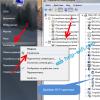The main elements of most of the used measuring instruments are primary measuring transducers, the purpose of which is to convert a measured physical quantity (input quantity) into a signal of measuring information (output quantity), usually electrical, convenient for further processing.
Primary converters are subdivided into parametric and generator. In parametric converters, the output value is a change in any parameter of an electrical circuit (resistance, inductance, capacitance, etc.), in generator converters, the output value is EMF, electric current or charge arising from the energy of the measured value.
There is a large class of measuring transducers in which the input quantities are pressure, force or torque. As a rule, in these transducers, the input quantity acts on the elastic element and causes its deformation, which is then converted either into a signal perceived by observers (mechanical indicating devices) or into an electrical signal.
To a large extent, the inertial properties of a converter are determined by the frequency of natural vibrations of an elastic element: the higher it is, the less inertial the converter is. The maximum value of these frequencies when using structural alloys is 50 ... 100 kHz. Crystalline materials (quartz, sapphire, silicon) are used for the manufacture of elastic elements of highly accurate transducers.
Resistive converters are parametric converters, the output quantity of which is a change in electrical resistance, which can be caused by the effect of quantities of various physical nature - mechanical, thermal, light, magnetic, etc.
Potentiometric transducer is a rheostat, the engine of which is stirred under the influence of the measured value (input value). The output quantity is resistance.
Potentiometric transducers are used to measure the position of regulating bodies (linear and angular), in level gauges, in sensors (for example, pressure) to measure the deformation of an elastic sensitive element. The advantage of potentiometric converters is a large output signal, stability of metrological characteristics, high accuracy, insignificant temperature error. The main disadvantage is the narrow frequency range (several tens of hertz).
The work of strain gages is based on a change in the resistance of conductors and semiconductors during their mechanical deformation (strain effect). A wire (or foil) strain gauge is a zigzag curved thin wire with a diameter of 0.02 ... 0.05 mm or a tape made of foil with a thickness of 4 ... 12 microns (lattice), which is glued to a substrate made of electrical insulating material. Lead copper conductors are connected to the ends of the lattice. The transducers, being glued to the part, perceive the deformation of its surface layer.
When measuring strains and stresses in parts and structures, as a rule, there is no possibility of calibrating the measuring channels and the measurement error is 2 ... 10%. In the case of using strain gauges in primary measuring transducers, the error can be reduced to 0.5 ... 1% by calibration. The main disadvantage of this type of strain gauge is the small output signal.
To measure small deformations of elastic sensitive elements of measuring transducers, semiconductor strain gauges are used, grown directly on an elastic element made of silicon or sapphire.
When measuring dynamic deformations with a frequency of up to 5 kHz, wire or foil strain gauges with a base of not more than 10 mm should be used, and the maximum deformation for them should not exceed 0.1% (0.02% for semiconductor).
The action of piezoelectric transducers is based on the occurrence of electric charges during crystal deformation (direct piezoelectric effect).
Piezoelectric transducers provide the ability to measure fast-variable quantities (the natural frequency of the transducers reaches 200 kHz), are highly reliable and have small overall dimensions and weight. The main disadvantage is the difficulty in measuring slowly changing quantities and in carrying out static calibration due to electricity leaks from the crystal surface.
An electrostatic converter can be schematically represented in the form of two electrodes (plates) with an area F, located in parallel at a distance d in a medium with a dielectric constant e.
Usually these converters are arranged in such a way that their output quantity is a change in capacitance (in this case, they are called capacitive), and the input quantities can be mechanical displacements that change the gap d or the area F, or a change in the dielectric constant of the medium e due to a change in its temperature, chemical composition, etc.
In addition to capacitance, EMF is used as the output value of electrostatic converters. generated by mutual movement of electrodes in an electric field (generator mode). For example, condenser microphones operate in generator mode, converting the energy of acoustic vibrations into electrical energy.
The advantage of electrostatic converters is the absence of noise and self-heating. However, in order to protect against interference, the connecting lines and the converters themselves must be carefully shielded.
For inductive converters, the output quantity is a change in inductance, and the input quantities can be displacements of individual parts of the converter, leading to a change in the resistance of the magnetic circuit, mutual induction between circuits, etc.
The advantages of the converters are: linearity of the characteristics, low dependence of the output signal on external influences, shocks and vibrations; high sensitivity. Disadvantages - a small output signal and the need for a supply voltage of increased frequency.
The principle of operation of vibration-frequency converters is based on a change in the frequency of natural vibrations of a string or a thin bridge when its tension changes.
The input quantity of the transducer is the mechanical force (or quantities converted into force - pressure, torque, etc.). which is perceived by an elastic element associated with the bulkhead.
The use of vibration-frequency converters is possible when measuring constant or slowly varying quantities over time (frequency no more than 100 ... 150 Hz). They are distinguished by high accuracy, and the frequency signal - increased noise immunity.
In optoelectric converters, the laws of propagation and interaction with matter of electromagnetic waves in the optical range are used.
The main element of the transducers are radiation receivers. The simplest of them - thermal converters - are designed to convert all the radiation energy incident on them into temperature (integral converter).
Various photoelectric converters are also used as radiation receivers, in which the phenomenon of the photoelectric effect is used. Photovoltaic converters are selective, i.e. they are highly sensitive in a relatively narrow wavelength range. For example, the external photoelectric effect (the emission of electrons under the action of light) is used in vacuum and gas-filled photocells and photomultipliers.
A vacuum photocell is a glass balloon, on the inner surface of which a layer of photosensitive material is applied, which forms a cathode. The anode is made in the form of a ring or a metal wire mesh. When the cathode is illuminated, a photoemission current occurs. The output currents of these elements do not exceed a few microamperes. In gas-filled photocells (inert gases Ne, Ar, Kr, Xe are used for filling), the output current increases 5 ... 7 times due to ionization of the gas by photoelectrons.
In photomultipliers, the primary photocurrent is amplified due to secondary electron emission - "knocking out" electrons from secondary cathodes (emitters) installed between the cathode and the anode. The overall gain in multistage photomultiplier tubes can be up to hundreds of thousands, and the output current is 1 mA. Photomultipliers and vacuum, elements can be used when measuring rapidly changing quantities, since the phenomenon of photoemission is practically inertialess.
Pressure measurement
To measure the total or static pressure, special receivers with inlet openings, which are connected with small diameter tubes (pneumatic lines) to the corresponding primary converters or measuring devices, will interfere with the flow.
The simplest total pressure receiver is a cylindrical tube with a perpendicularly cut end, bent at a right angle and oriented towards the flow. To reduce the sensitivity of the receiver to the direction of flow (for example, when measuring in flows with small swirl), special receiver designs are used. For example, total pressure receivers with a flow (Fig. 3.3) are characterized by a measurement error of no more than 1% at bevel angles up to 45 ° at the number M<0,8.
When measuring static pressures near the channel walls, receiving holes with a diameter of 0.5 ... 1 mm are made directly in the walls (drain holes). The drainage area must be free of irregularities and the edges of the holes must be free of burrs. This type of measurement is very common in the study of flows in pipes and channels in combustion chambers, diffusers and nozzles.
| |
Rice. 3.3. Total pressure receiver schematic:

Rice. 3.4. Static pressure receiver schematic:
a - wedge-shaped;
b - disk;
c - L-shaped for measurements at M £ 1.5
Wedge-shaped and disk receivers, as well as receivers in the form of L-shaped tubes (Fig. 3.4) with receiving holes located on the lateral surface, are used to measure static pressures in the flow. These receivers work well at subsonic and low supersonic speeds.
To study the distribution of pressures in the cross-sections of channels, combs of full and static pressures, containing several receivers, or combined combs, having a receiver of both full and static pressures, have become widespread. When measuring in flows with a complex flow structure (combustion chambers, inter-blade channels of turbomachines), oriented and non-oriented pressure transducers are used, which make it possible to determine the values of the total and static pressures and the direction of the velocity vector. The first of them are intended for measurements in two-dimensional flows, and their design makes it possible to rotate the receiver in a certain position relative to the vector of the local flow velocity.
Non-orientable receivers are equipped with several receiving holes (5 ... 7), which are made in the walls of a cylinder or sphere of small diameter (3 ... 10 mm) or located at the ends of tubes cut at certain angles (diameter 0.5 ... 2 mm ), combined into a single structural unit (Fig. 3.5). When the flow is flowing around the receiver, a certain pressure distribution is formed around it. Using the pressure values measured through the inlet ports and the results of the preliminary calibration of the receiver in the wind tunnel, the total and static pressures and the local direction of the flow velocity can be determined.
At supersonic flow velocities, shock waves appear in front of the pressure receivers, and this must be taken into account when processing the measurement results. For example, from the measured values of the static pressure in the stream p and the total downstream shock p * ", it is possible to determine the number M using the Rayleigh formula, and then the value of the total pressure in the stream:
When testing engines and their elements, various devices are used to measure pressures (deformation dial gauges, liquid, group recording pressure gauges), which allow the operator to control the operating modes of experimental objects. Various primary converters are used in information-measuring systems. As a rule, pressure, more precisely the difference in pressure (for example, between measured and atmospheric, between full and static, etc.), acts on an elastic sensitive element (membrane), the deformation of which is converted into an electrical signal. Most often, inductive and strain-sensitive transducers are used for this when measuring constant and slowly varying pressures and piezo-crystalline and inductive transducers when measuring alternating pressures.
 Rice. 3.5. Diagram of a five-channel pressure receiver:
Rice. 3.5. Diagram of a five-channel pressure receiver:
С x, С y, С z - components of the velocity vector; p i - measured pressure values
As an example, Fig. 3.6 shows a diagram of the "Sapphire-22DD" converter. Transmitters of this type are available in several versions, designed to measure gauge pressure, differential pressure, vacuum, absolute pressure, gauge pressure and vacuum in various ranges. The elastic sensitive element is a metal membrane 2, to which a sapphire membrane with deposited silicon strain gauges is soldered on top. The measured pressure difference acts on a block consisting of two diaphragms 5. When their center is displaced, the force is transferred by means of thrust 4 to lever 3, which leads to deformation of the membrane 2 with strain gauges. The electrical signal from the strain gauges enters the electronic unit 4, where it is converted into a unified signal - a direct current of 0 ... 5 or 0 ... 20 mA. The converter is powered from a 36 V DC source.


When measuring variable (for example, pulsating) pressures, it is advisable to bring the primary transducer as close as possible to the place of measurement, since the presence of a pneumatic line introduces significant changes in the amplitude-frequency characteristic of the measurement system. The ultimate in this sense is the drainless method, in which miniature pressure transducers are mounted flush with the streamlined surface (channel wall, compressor blade, etc.). Known transducers having a height of 1.6 mm and a membrane diameter of 5 mm. Systems with pressure transducers and waveguides (l ~ 100 mm) (the method of remote pressure transducers) are also used, in which, to improve the dynamic
characteristics, corrective acoustic and electrical links are used.
With a large number of measuring points in measuring systems, special fast-acting pneumatic switches can be used, which provide alternate connection of several tens of measuring points to one transmitter.
To ensure high accuracy, it is necessary in working conditions to periodically monitor pressure measuring instruments using automatic setpoints.
Temperature measurement
 A variety of measuring instruments are used to measure temperatures. A thermoelectric thermometer (thermocouple) consists of two conductors made of different materials, connected (welded or soldered) to each other (seals). If the temperatures of the junctions are different, then a current will flow in the circuit under the action of a thermoelectromotive force, the value of which depends on the material of the conductors and on the temperatures of the junctions. During measurements, as a rule, one of the junctions is thermostated (melting ice is used for this). Then the emf of the thermocouple will be uniquely related to the temperature of the "hot" junction.
A variety of measuring instruments are used to measure temperatures. A thermoelectric thermometer (thermocouple) consists of two conductors made of different materials, connected (welded or soldered) to each other (seals). If the temperatures of the junctions are different, then a current will flow in the circuit under the action of a thermoelectromotive force, the value of which depends on the material of the conductors and on the temperatures of the junctions. During measurements, as a rule, one of the junctions is thermostated (melting ice is used for this). Then the emf of the thermocouple will be uniquely related to the temperature of the "hot" junction.
Dissimilar conductors can be included in the thermoelectric circuit. In this case, the resulting EMF will not change if all the joints are at the same temperature. This property is based on the use of so-called extension wires (Fig. 3.7), which are connected to thermoelectrodes of limited length, and such  thus saving expensive materials is achieved. In this case, it is necessary to ensure the equality of temperatures at the points of connection of the extension wires (T c) and the thermoelectric identity of their main thermocouple in the range of possible temperature changes T c and T 0 (usually no more than 0 ... 200 ° C). In the practical use of thermocouples, cases are possible when the temperature T 0 is different from 0 ° C. Then, to take this circumstance into account, the emf of the thermocouple
thus saving expensive materials is achieved. In this case, it is necessary to ensure the equality of temperatures at the points of connection of the extension wires (T c) and the thermoelectric identity of their main thermocouple in the range of possible temperature changes T c and T 0 (usually no more than 0 ... 200 ° C). In the practical use of thermocouples, cases are possible when the temperature T 0 is different from 0 ° C. Then, to take this circumstance into account, the emf of the thermocouple  should be determined as E = E meas + DE (T 0) and find the temperature value from the calibration dependence. Here E meas is the measured value of the EMF; DE (T 0) - EMF value corresponding to the value of T 0 and determined from the calibration dependence. Calibration dependences for thermocouples are obtained at a temperature of "cold" junctions T 0 equal to 0 ° C. These dependencies are somewhat different from linear ones. As an example, Fig. 3.8 shows the calibration dependence for a platinum-rhodium-platinum thermocouple.
should be determined as E = E meas + DE (T 0) and find the temperature value from the calibration dependence. Here E meas is the measured value of the EMF; DE (T 0) - EMF value corresponding to the value of T 0 and determined from the calibration dependence. Calibration dependences for thermocouples are obtained at a temperature of "cold" junctions T 0 equal to 0 ° C. These dependencies are somewhat different from linear ones. As an example, Fig. 3.8 shows the calibration dependence for a platinum-rhodium-platinum thermocouple.
Some characteristics of the most common thermocouples are given in table. 3.1.
 In practice, the most common thermocouples with an electrode diameter of 0.2 ... 0.5 mm. Electrical insulation of electrodes is achieved by wrapping them with asbestos or silica thread, followed by impregnation with heat-resistant varnish, placing thermoelectrodes in ceramic tubes or stringing pieces of these tubes ("beads") on them. Cable-type thermocouples have become widespread, which are two thermoelectrodes placed in a thin-walled shell made of heat-resistant steel. To insulate thermoelectrodes, the inner cavity of the shell is packed with MgO or Al 2 O 3 powder. The outer diameter of the sheath is 0.5 ... 6 mm.
In practice, the most common thermocouples with an electrode diameter of 0.2 ... 0.5 mm. Electrical insulation of electrodes is achieved by wrapping them with asbestos or silica thread, followed by impregnation with heat-resistant varnish, placing thermoelectrodes in ceramic tubes or stringing pieces of these tubes ("beads") on them. Cable-type thermocouples have become widespread, which are two thermoelectrodes placed in a thin-walled shell made of heat-resistant steel. To insulate thermoelectrodes, the inner cavity of the shell is packed with MgO or Al 2 O 3 powder. The outer diameter of the sheath is 0.5 ... 6 mm.
Table 3.1
To correctly measure the temperature of structural elements, thermocouples must be sealed in such a way that the hot junction and thermoelectrodes near it do not protrude above the surface and that the conditions for heat transfer from the surface to be measured are not violated due to the installation of the thermocouple. To reduce the measurement error due to the outflow (or influx) of heat from the hot junction along thermoelectrodes due to thermal conductivity, thermoelectrodes at a certain distance near the junction (7 ... 10 mm) should be laid approximately along the isotherms. The termination diagram of a thermocouple that meets the specified requirements is shown in Fig. 3.9. A groove with a depth of 0.7 mm is made in the part, into which the junction and adjacent thermoelectrodes are placed; the seam is welded to the surface by resistance welding; the groove is covered with a foil 0.2 ... 0.3 mm thick.
The withdrawal of thermoelectrodes from the internal cavities of the engine or its units is carried out through the union. In this case, it is necessary to ensure that the thermoelectrodes do not disturb the flow structure too much and that their insulation is not damaged due to friction against each other and against the sharp edges of the structure.
When measuring the temperatures of rotating elements, thermocouple readings are derived using brush or mercury current collectors. Non-contact current collectors are also being developed.
The thermocouple schemes used to measure the gas flow temperature are shown in Fig. 3.10. Hot junction 1 is a sphere with a diameter d 0 (thermoelectrodes can also be butt-welded); thermoelectrodes 2 near the junction are fixed in an insulating two-channel ceramic tube 3, and then removed from the housing 4. In the figure, housing 4 is shown as water-cooled (cooling is necessary when measuring temperatures exceeding 1300 ... 1500 K), the supply and discharge of cooling water are carried out through the union 5 ...
At high values of the gas temperature, methodological errors arise due to heat removal from the junction due to thermal conductivity along thermoelectrodes to the thermocouple body and radiation into the environment. Heat loss due to thermal conductivity can be almost completely eliminated by providing an overhang of the insulating tube equal to 3 ... 5 of its diameters.
To reduce heat removal by radiation, shielding of thermocouples is used (Fig. 3.10, b, c). This also protects the junction from damage, and the inhibition of the flow inside the screen contributes to an increase in the temperature recovery coefficient when measuring in high-speed flows.
A method has also been developed for determining the gas temperature from the readings of two thermocouples with thermoelectrodes of different

Rice. 3.9. Thermocouple termination diagram for measuring the temperature of the elements of combustion chambers

Rice. 3.10. Thermocouple circuits for measuring gas temperature:
a - thermocouple with an open junction: b, c - shielded thermocouples; d - double-seam thermocouple; 1 - junction: 2 - thermoelectrodes; 3 - ceramic tube; 4 - case; 5 - fittings for water inlet and outlet
diameter (Fig. 3.10, d), allowing to take into account the removal of heat by radiation.
The inertia of the thermocouples depends on the design. So, the time constant varies from 1 ... 2 s for thermocouples with an open junction, to 3 ... 5 s for shielded thermocouples.
When studying temperature fields (for example, behind a turbine, a combustion chamber, etc.), thermocouple combs are used, and in some cases they are installed in rotating turrets, which makes it possible to determine in sufficient detail the temperature distribution over the entire cross section.
The action of a resistance thermometer is based on the change in the resistance of a conductor with a change in temperature. As an electrical resistance, a wire with a diameter of 0.05 ... 0.1 mm is used, made of copper (t = -50 ... + 150 ° С), nickel (t = -50 ... 200 ° С) or platinum ( t = -200 ... 500 ° C).
The wire is wound on a frame and placed in a cover. Resistance thermometers have high accuracy and reliability, but they are characterized by high inertia and are not suitable for measuring local temperatures. Resistance thermometers are used to measure the temperature of the air at the inlet to the engine, temperatures of fuels, oils, etc.
Liquid thermometers exploit the thermal expansion property of a liquid. Mercury (t = -30 ... + 700 ° C), alcohol (t = -100 ... + 75 ° C), etc. are used as working fluids. Liquid thermometers are used to measure the temperature of liquid and gaseous media in laboratory conditions , as well as when calibrating other devices.
Optical methods for measuring temperature are based on the laws of thermal radiation from heated bodies. In practice, three types of pyrometers can be implemented: brightness pyrometers, whose operation is based on a change in the thermal radiation of a body with temperature at a certain fixed wavelength; color pyrometers using temperature-dependent energy distribution within a certain region of the radiation spectrum; radiation pyrometers based on the temperature dependence of the total amount of energy emitted by the body.
At present, when testing engines for measuring the temperatures of structural elements, brightness pyrometers created on the basis of photoelectric receivers of radiant energy have been used. As an example, the installation diagram of a pyrometer for thermometry of turbine blades with a running engine is shown in Fig. 32.11. With the help of lens 2, the "field of view" of the primary transducer is limited to a small (5 ... 6 mm) area. A pyrometer "inspects" the edge and back portion of each vane. Protective glass 1 made of sapphire protects the lens from dirt and overheating. The signal is transmitted through the light guide 3 to the photodetector. Due to its low inertia, the pyrometer allows you to control the temperature of each blade.
To measure the temperatures of engine structural elements, color temperature indicators (thermal paints or thermal varnishes) can be used - complex substances that, upon reaching a certain temperature (transition temperature), sharply change their color due to the chemical interaction of components or phase transitions occurring in them.

Rice. 3.11. Installation diagram of the pyrometer on the engine:
(a) (1 - blowing air supply; 2 - primary converter) and primary converter circuit
(b) (1 - protective glass; 2 - lens; 3 - light guide)
Thermal paints and thermo lacquers, being applied to a hard surface, after drying, harden and form a thin film that can change its color at the transition temperature. For example, white thermal paint TP-560 becomes colorless when t = 560 ° С.
With the help of thermal indicators, it is possible to detect overheating zones in engine elements, including in hard-to-reach places. The complexity of the measurements is small. However, their use is limited, since it is not always possible to establish in which mode the maximum temperature was reached. In addition, the color of the thermal indicator depends on the time of exposure to temperature. Therefore, thermal indicators, as a rule, cannot replace other measurement methods (for example, using thermocouples), but they provide additional information about the thermal state of the object under study.
General remarks. Parametric converters, as noted in Section 1, control the parameters of the energy flow coming from an external source, and can operate in one of two modes. In the first one, the converter is a constant current or voltage regulator.
The measurement information is carried by the law of change in the level of an electrical quantity. Although such a converter must in principle be a nonlinear system, under certain conditions its output signal can be considered linearly related to the input one, and there is even an analogy with generator IEDs. For example, in the simplest case, a converter having an electrical impedance is connected in series with the load and is powered from a source with and internal resistance.
The nonlinearity of the transformation introduces the product But at
If the impedance is linearly related to the input magnitude of the MEP (usually this is a displacement, i.e., then you can write
![]()
If an electric force acts in the transducer and where do not depend on, then the equation of the balance of forces takes the form
The last two equations are similar to the system of equations (1) and (2), and If then such a converter is equivalent to a generator IEP, and it can be called quasi-convertible. For it, the general remarks of Section 2 remain valid. A converter supplied with direct current can be quasi-reversible only if the energy of the power source is spent mainly on creating an electric or magnetic field in the converter. If iola is small, then ponderomotive signals are also absent. Practically the same result is obtained when supplying with alternating current due to the difference in the spectral composition of the input and output quantities (the converter, being a modulator, carries out the transfer of the spectrum, see Ch. 10).
The output signal of the converter can be current (at or voltage across the load (in the opposite case).
In addition to the current regulator mode, the parametric MEP can operate in the exciter mode, being a part of the frequency-driving circuit of a self-excited generator. The measured value modulates the frequency of the generated voltage. The change in frequency can be directly used as an output signal or converted to another form (discrete or analog). In this mode, the converter is always irreversible.

Rice. 10. Capacitive transducer: o - with variable gap (area); 6 - with variable permeability; в - differential
The output signal of a parametric MEP powered by an alternating current must undergo detection (demodulation), usually performed in an amplifier-converting equipment. Since this signal acts against the background of another, which does not carry useful information, but is stronger due to the fact that it is isolated by differential or bridge circuits.
Capacitive converter. The principle of operation of this converter is based on the dependence of the capacitance between the conductors on their relative position, size and properties of the medium between them. In the simplest case of a flat capacitor, its capacitance is
where is the area of the electrodes; 6 - the gap between them; effective (i.e., taking into account the inhomogeneity of properties) dielectric constant of the interelectrode space. Possible schematic diagrams of a capacitive converter are shown in Fig. 10. There are two types of dependences of the capacitance on the displacement x of one of the electrodes:
The first of them corresponds to a change in the area or effective permeability, the second to a change in the gap.
For the first kind
and for the second
![]()
Thus, equation (30) can be written as follows:

where or for species 1 and 2, respectively.
The expression for essentially depends on the electrical mode of the converter. Due to the complexity of the analysis in general, we will restrict ourselves to two extreme cases when powered from a constant voltage source.
1 Changes in capacitance occur so slowly that the power source has time to charge the capacitance practically without delay, maintaining the same voltage on it, equal if other capacitances are not connected in series with the converter Then (32) takes the following form:
![]()
On the other hand, and since equal to or -

Since the charge on the container
where is the variable part of the charge, then for type 2 you can write:
2. Changes in the capacitance occur so quickly that the charge on it does not have time to change significantly and remains equal to the initial value. Therefore, the voltage across the capacitance changes according to the law. only for the initial charge of the capacitor (neglecting the leakage current). However, there is a small current through the load supported by the work of an external force. For the dependence of the first type of capacitance on displacement (see page 197)
that is, in addition to the constant force, there is additional electrical elasticity. For dependence of the second kind
![]()
Equation (32) is written in the following form
the second term is explained by the fact that at the beginning (at) the impedance is capacitive? and not the load, determines the nature of the initial current.
The converter equations in all modes and their solutions are summarized in table. 2.
2. Equations of the capacitive converter
(see scan)
From those given in table. 2 expressions, it can be seen that in all cases the output current directly or indirectly depends on. When operating in constant voltage mode and with an elastic character, the converter is a differentiator. In the constant charge mode, the output signal depends on the type of load, in particular, if the load is active, then the current is proportional to the strength. However, in any case, it is impossible to measure constant forces or displacements. 2 that in one of the modes the converter is quasi-reversible.
When the converter is powered from an alternating voltage source, the current flows through it, even if the capacitance does not change, and the current can serve as a measure of the capacitance for any law of its change. For the calculation, you should use equation (32) taking into account what is a function For example, when supplying a sinusoidal voltage of frequency, the formulas in Table. 2, you can determine the amplitude of the output current if, instead of the expression standing in front of you take its modulus at Frequency called the carrier, you choose much more than the highest frequency in the spectrum. Depending on the ratio, the converter can operate in two extreme modes of short circuit and no-load.
![]()
and in the second
![]()
Expressions for are divided into two parts, the first does not depend on time, and the second pulsates with a frequency almost always they can be neglected (see below), the converter is considered irreversible
The calculation shows that with the right choice in any mode, the amplitude of the output of the transducer can be proportional to the acting force. For example, for idle and variable clearance
![]()
Therefore, it is necessary to choose so that the denominator is constant. When the impedance is elastic, this corresponds to a resistive load: Bridge circuits are usually used for measurement.
The largest specific force of attraction of the transducer electrodes is determined by the breakdown field strength and for air is. If the acting force in all modes is significantly greater than the electrical interaction force, then the use of the converter only at narrows the possible range of variation of the input value. An increase leads to a rapid increase in the conversion nonlinearity, which can be reduced by using various linearization methods. One of them is the use of differential converters (Fig. 10, c), in which the capacitances change simultaneously in different directions. In this case, along with linearization and an increase in sensitivity, good compensation for the influence of external conditions is achieved. Linearity increases significantly if the output is the inverse of AC, such as a change in capacitance. Its linear connection with x is observed up to the closure of the electrodes of the transducer. Direct linearization can be performed by converting the output signal in an additional microprocessor-based unit, which is now quite possible even in self-powered devices.
If the capacitance is included in the driving circuit of an alternating voltage generator, then it is possible to measure not currents or voltages, but time parameters - frequency or duration. In a classical generator with inductance, the oscillation period is proportional, and in a resistive-capacitive generator it is linearly dependent on C. This method has great flexibility, since you can always choose the optimal type of output signal. For example, when the converter is switched on with a variable gap in the circuit of a resistive-capacitive generator, the oscillation frequency
![]()
The change in frequency is proportional to x and it is advisable to use it as an output signal. If the transducer has a variable area, then the oscillation period is linearly related to the displacement

Therefore, in both cases, it is possible to operate without the above limitation with great overload resistance. When the converter is connected to the oscillatory circuit, these properties are largely lost, but much greater stability of the generator parameters is achieved. Therefore, the latter method is widely used in highly sensitive and stable measuring systems. A converter with a frequency output is irreversible in all cases.
The sensitivity of a capacitive transducer is determined by its geometric relationships, supply voltage and stability of structural elements. The highest sensitivity is achieved with a variable gap, however, at the same time, the upper measurement limit is reduced. Therefore, the applications for variable area and variable gap converters are different. Transducers with variable permeability are rarely used in mechanical measurement technology, although there are crystalline substances with a large dependence of permeability on mechanical stress. Such dielectrics can be effective in force and pressure transducers.
Capacitive transducers are used to measure forces and quantities reduced to them, as well as displacements, especially small and ultra-small ones.
Inductive converter. The action of inductive MEP is based on the use of the dependence of the inductance of a circuit with a current or the mutual inductance of two connected circuits on their size, shape, relative position and magnetic permeability of the medium in which they are located. In particular, the inductance of a coil with a magnetic core having a gap depends on the length of the latter (Fig. I).
Let us assume that the annular gap through which the lines of force passing outside the coil are closed is so small that it can be neglected. If we denote by the absolute magnetic permeability of the core; I is the average length of the field line in the core; inductance of the coreless coil, then the inductance shown in fig. 11 coils where the effective magnetic permeability, taking into account the gap;
![]()
This formula is valid for If, in addition to this, then
![]()
In this way,
where the inductance at

Rice. 11. Inductive converter: 1 - fixed core; 2 - coil; 3 - movable core
The energy of the magnetic field in the coil
![]()
where is the current at If we restrict ourselves to terms of the second order of smallness and take into account that then

Substituting these quantities in (30), (31) and taking into account that we obtain the converter equations

It can be seen from these equations that the transformer is quasi-invertible with a coefficient (but not) equal to
Output current
As usual, the transducer is differentiating in the pre-resonant region, and a scale transducer behind the resonance. Power supply of an inductive converter with a constant voltage is not practiced, because, unlike a capacitive one, it consumes energy that is uselessly spent on its active resistance. When powered by alternating voltage, energy consumption decreases and becomes
possible measurement of constant values. The output parameters are calculated in the same way as for a capacitive converter. The conclusions about the possibility of using temporary or frequency methods of measurement and linearization remain valid.
The converters have many designs. In addition to converters with a variable gap length, which are characterized by the greatest sensitivity to the movement of the core, converters with a variable gap area are known; with an open magnetic circuit (without a fixed core); with variable mutual inductance, etc. Their sensitivity is sufficient to measure displacements up to
Inductive transducers are used to measure displacements and the forces and pressures converted into them.
Magnetoelastic transducer differs from inductive in the mechanism of inductance change. It is carried out by direct action of force on the ferromagnetic core (Fig. 12). It is known that the permeability of a ferromagnet depends on the mechanical stresses in the material. If, in the absence of voltage, the permeability is equal, then the creation of stress a changes it to The sensitivity of the ferromagnet to stresses is characterized by a coefficient that depends on a and the field in the ferromagnet. top end, height, then
![]()

Rice. 12. Magnetoelastic transducer: 1 - core; 2 - coil
Substituting this value in (30), we obtain the equation for the output current of the converter. The magnetoelastic transducer is always supplied with alternating voltage, which is why it is practically irreversible. The output signal is found using a formula similar to (35). Since the values of the coefficient can reach several hundred, the converter is sensitive to low voltages. However, noise in a ferromagnet and hysteresis phenomena limit the minimum measured voltages to a value of the order of
The natural field of application of the magnetoelastic transducer is the measurement of forces and pressures. However, it is used less often than inductive, mainly for measuring slowly changing quantities of the same sign.
Resistive converters. The action of resistive MEP is based on the use of the dependence of the quantities included in the formula for the electrical resistance - the length of the conductor of its cross-section and the specific electrical conductivity of the material y - from mechanical influences. In the simplest case, a resistive MEP is a straight or coiled wire with a variable active length determined by the position of the sliding contact (Fig. 13). Such a converter is called rheostat. The shown transducer with a spiral winding is not analog, but discrete with a step equal to the turn-to-turn distance. When the contact is moved by x, the relative change in resistance is equal to where I is the length of the winding. Thus, it can vary from up to one, but usually the initial position of the contact is chosen in the middle of the winding. Another example is a strain gage - a current-carrying element subject to deformation, often uniaxial (Fig. 14). In this case, all the quantities on which the resistance depends are changed.
To assess the properties of the strain gauge material, a strain gage coefficient is introduced, equal to Calculation of the change in the dimensions of the wire during deformation
gives for the value where Poisson's ratio equal to But since, in addition to this, the density of the material changes, and therefore the concentration of charge carriers, and the crystal lattice is deformed, turns out to be much larger for metals). In semiconductors, where there are two types of charge carriers and mechanical stresses change the structure of the energy bands and the carrier mobility, the tensosensitivity coefficient is an order of magnitude higher, but depends on the type of conductivity, its value and the orientation of the resistor axis relative to the crystallographic axes of the material.

Rice. 13. Rheostat converter

Rice. 14. Strain gauge transducer
In resistive converters, the effect of the electrical side on the mechanical side can be completely neglected and both can be considered as independent. The mechanical impedance of the strain gauge is relatively low and elastic; in a rheostatic transducer, the sliding contact is a non-linear element (such as friction without lubrication). The sensitivity of resistive converters of both types, for example, current, is determined by the formulas
where is the coefficient of transformation of the object's deformation into the strain of the strain gauge. The transfer of deformation is carried out either along the entire length of the strain gauge, or at separate points. The designs of strain gage MEP are various. They are made of various shapes from wire, foil, sprayed film or a piece of single crystal.
The sensitivity of strain gauge IEDs allows you to measure dynamic deformations up to
Rheostat transducers are used to measure relatively large relative displacements, and tensoresistive transducers are used to measure deformations and the quantities converted into them: forces, pressures, moments.
Variable characteristic converters. A special type of parametric MEP is represented by converters with a nonlinear volt-ampere characteristic that changes under mechanical action on the converter. A typical example is a vacuum tube transducer - an electric vacuum device with a movable electrode. In fig. 15 shows schematically a diode vacuum tube with a movable anode. When the anode moves relative to the cathode, which occurs under the action of a force on the elastic membrane, the diode - the dependence of the anode current on the voltage between the electrodes - changes. This can be seen from the formula for the anode current
![]()
where B is a coefficient depending on the material and temperature of the cathode and the area of the electrodes; anode voltage. The change is shown in Fig. 16, in the right quadrant of which a family of characteristics is shown at different interelectrode distances. The depiction of dependences in the form of graphs is often the only possible one if there are no analytical expressions that have sufficient accuracy. Since a load resistor is included in the diode circuit, equality is fulfilled, as a result of which the current changes in accordance with the dynamic characteristic, the construction of which is shown in the left quadrant of Fig. 16. Despite the pronounced nonlinearity of the initial I – V characteristics, the dynamic characteristic is close to a straight line.

Rice. 15. Diode mechatronic transducer: 1 - membrane, 2 - movable aiod

Rice. 16. Scheme for constructing the dynamic characteristics of the converter
Counting the displacement of the anode x from the initial distance 60 and denoting it is possible to write down, therefore, the equations of the converter:

Thus, both equations are independent. Converter output current
The mechanical impedance of the vacuum tube is significant. In the pre-resonant region, which is usually working for this type of IED, the transducer will be large-scale.
The diode mechanotron is the simplest in the series of converters with movable electrodes. Designs have been developed with two anodes and a differential switching circuit, made using both diode and triode circuits, with a sensitivity of up to several hundred microamperes per micrometer. Due to their high rigidity, mechatrons are more suitable for measuring forces and pressures.
Along with vacuum converters, solid-state converters are known - semiconductor diodes and triodes (transistors), in which it is a function of mechanical stress applied to the active region of the crystal: a junction, a channel. Almost all known types of semiconductor devices can be used for this purpose. The effect here is achieved due to the fact that when the size of the active region changes, the concentration and mobility of charge carriers change, and in the field-effect transistor with an insulated gate, there is also piezoelectric polarization in the insulating layer. Semiconductor MEPs of this type have a significantly lower mechanical impedance than the mechanotron, and can measure small forces, since their sensitivity is high; but
stability is not good enough. They have not yet become widespread.
Resonator converters. Converters of this type are generators with electromechanical feedback through a frequency-selective element, the parameters of which depend on the impact produced on it (Fig. 17). A generator with a piezoelectric resonator in the feedback circuit is excited at a frequency equal to where is the propagation velocity of the sound waves used; integer; I is the path length of the waves in the resonator. If a force acts on the resonator, its dimensions and mechanical properties, and with them the generation frequency, change in the first approximation in proportion to the force. Thus, the converter is a power-controlled generator with frequency modulation and is close to a capacitive or inductive MEP with a frequency output, but the latter uses not mechanical, but electrical resonance. But
where is the mass of the resonator; thickness; shear modulus in direction
Stability is determined by the stability of the combination of geometric and elastic parameters in parentheses. In this case, the elimination of energy leaks generated in the resonator is of great importance, which is achieved by a rational choice of the type of excited waves, the design of the resonator and connecting elements.
It is inexpedient to describe resonator IEPs by the system of equations (1) and (2), since they have a frequency output, and the reverse influence of the electrical side on the mechanical side is determined by weak effects of the second order of smallness, and can be neglected.
The most common resonator MEPs of another type - the so-called vibration-frequency (string). Their action is based on the fact that the natural frequency of a string stretched with effort is proportional.Consequently, if the frequency deviation from
the initial value is proportional. However, solid-state resonators have good prospects, since they have a number of advantages, in particular, in terms of speed. Their sensitivity makes it possible to measure forces that cause voltages of the order. There are also known transducers with purely electric resonators of the klystron type, which, however, did not go beyond laboratory studies due to significant operational inconveniences. Resonator MEPs are used to measure forces and quantities that can be reduced to them.

Rice. 18. Eddy current transducer
Eddy current transducer. The action of eddy-current (or eddy-current) converters is based on the use of the phenomenon of electromagnetic induction. If there is a conducting body in the magnetic field of the current, then when the field changes, short-circuited (eddy) currents are excited in it, sucking out the field energy
And R / is the value of the resistance of the slidewire per unit length of winding of the slidewire. [...]
Thus, the linear movement of the slidewheel slider at a constant temperature of the free ends of the thermocouple is directly proportional to the measured temperature, and therefore, the slidewire resistance can be expressed directly in degrees of the measured temperature. [...]
The power supply of the measuring compensation circuit is usually carried out from a dry cell, e. etc. with. which decreases over time, and, consequently, the current in the reochord circuit changes. To exclude an error due to a change in the current in the slidewire circuit, the current value must be periodically monitored. [...]
The control of the current in a compensation measurement circuit is usually carried out by means of a normal element. A diagram in which such a control is possible is shown in FIG. 1-16. [...]
When the temperature of the free ends of the thermocouple changes by D e. etc. with. thermocouple will change by the AE value. This change is e. etc. with. will introduce an error in the readings of the device made according to the circuit shown in FIG. 1-1a. [...]
In the circuit shown in FIG. 1-16, compensation for the influence of temperature changes of the risers is provided. For this purpose, the circuit has a Pit resistance made of nickel or copper wire. The Dm resistance is located directly near the clamps to which the free ends of the thermocouple are connected (thus, the Dm resistance and the free ends of the thermocouple have the same temperature). With an increase in the temperature of the free ends of the thermocouple, the resistance Dm increases in proportion to the change in the temperature of the free ends. You have selected the resistance value so that its change leads to a change in the compensating voltage by the value of e -D E, and thereby eliminates the error from a change in the temperature of the free ends. [...]
In the considered scheme, the resistances Dn and To are intended to adjust the measurement limit, the resistance Er - to limit the current in the circuit of the normal element. [...]
Potentiometer
Potentiometer- an adjustable voltage divider, which is, as a rule, a resistor with a movable tap-off contact (slider). With the development of the electronics industry, in addition to the "classic" potentiometers, digital potentiometers also appeared. (e.g. AD5220 from Analog Devices). Such potentiometers, as a rule, are ICs that do not have moving parts and allow you to programmatically set their own resistance with a given step.
Most varieties of variable resistors can be used both as potentiometers and as rheostats, the difference in connection schemes and in purpose (potentiometer - voltage regulator, rheostat - current strength).
Potentiometers are used as regulators of parameters (sound volume, power, output voltage, etc.), to adjust the internal characteristics of equipment circuits (trimmer), many types of angular or linear displacement sensors are built on the basis of precision potentiometers.
Measurement
resistance compensation method
Compensation measurement method, a measurement method based on compensation (equalization) of the measured voltage or emf by the voltage created across a known resistance by a current from an auxiliary source. K. m. And. used not only for measuring electrical quantities (emf, voltages, currents, resistance); it is also widely used to measure other physical quantities (mechanical, light, temperature, etc.), which are usually preliminarily converted into electrical quantities.
K. m. And. is one of the variants of the comparison method with a measure, in which the resulting effect of the influence of the quantities on the comparison device is brought to zero (a zero reading of the measuring device is achieved). K. m. And. is characterized by high accuracy. It depends on the sensitivity of the zero device (zero indicator), which controls the implementation of compensation, and on the accuracy of determining the value that compensates for the measured value.
K. m. And. the electric voltage in the DC circuit is as follows. Measured voltage U x(cm. rice. ) is compensated by the voltage drop created across a known resistance r current from an auxiliary source U ex(working current l p). Galvanometer G(zero device) is included in the circuit of compared voltages by moving the switch (P on rice. ) to the right position. When the voltages are compensated, the current in the galvanometer, and therefore in the circuit of the measured voltage U x missing. This is a great advantage of K. m. And. before other methods, since it allows you to measure the total emf of the source U x and , in addition, the results of measurements by this method are not affected by the resistance of the connecting wires and the galvanometer. The operating current is set according to the normal element E N with a known emf, compensating for it by a voltage drop across the resistance R(switch P - in the left position). Voltage value U x found by the formula U x= E N· r / R, where r-resistance, the voltage drop on which compensates U x.
When measured by the compensation method, the current strength I x this current is passed at a known resistance R 0 and measure the voltage drop across it l x R 0. Resistance R 0 include instead of the one shown in Fig. voltage source U x... To measure power, it is necessary to measure voltage and current in turn. To measure resistance, it is connected to an auxiliary circuit in series with a known resistance and the voltage drops across them are compared. Electrical measuring instruments based on K. m. And. Are called potentiometers or electrical compensators. K. m. And. also applicable for measuring AC values, albeit with lower accuracy. K. m. And. widely used in technology for the purpose of automatic control, regulation, control.
28. Tests. Basic terms. Preliminary tests. Acceptance tests. Departmental tests. State tests. periodic tests. Parametric tests. Reliability tests. Accelerated tests. Research trials. Climatic tests. Electrical tests. Mechanical tests. Comparative tests. Organization of tests
Testing
Tests as the main form of control of electronic equipment (IET) are the experimental determination of quantitative and qualitative indicators of the properties of a product as a result of exposure to it during its operation, as well as during object modeling. The objectives of the tests are different at different stages of the design and manufacture of the IEP. The main objectives of the tests include:
a) the choice of optimal design and technological solutions when creating new products;
b) fine-tuning of products to the required quality level;
c) an objective assessment of the quality of products when they are put into production and during the production process;
d) guaranteeing the quality of products in the international exchange of goods.
Tests serve as an effective means of improving quality, as they allow you to identify:
a) shortcomings in the design and manufacturing technology of IEP, leading to the disruption of the performance of the specified functions under operating conditions;
b) deviations from the chosen design or adopted technology;
c) hidden defects in materials or structural elements that cannot be detected by existing methods of technical control;
d) reserves for improving the quality and reliability of the developed constructive and technological version of the product.
Based on the results of testing products in production, the developer establishes the reasons for the decline in quality.
This paper discusses the classification of the main types of IEP tests and the procedure for their implementation.
Basic terms
Testing is a kind of control. The test system includes the following main elements:
a) test object - a product being tested. The main feature of the test object is that, based on the test results, a decision is made on this particular object: on its suitability or rejection, on the possibility of presenting it for subsequent tests, on the possibility of serial production, etc. The characteristics of the properties of an object during testing can be determined by measurements, analyzes or diagnostics;
b) test conditions are a combination of influencing factors and (or) modes of operation of an object during testing. Test conditions can be real or simulated, provide for the determination of the characteristics of the object during its functioning and non-functioning, in the presence of impacts or after their application;
c) test means are technical devices required for testing. This includes measuring instruments, test equipment and auxiliary technical devices;
d) test performers are personnel involved in the test process. Requirements for qualifications, education, work experience and other criteria are imposed on him;
e) normative and technical documentation (NTD) for testing, which is a set of standards governing the organizational, methodological and normative and technical basis of testing; a set of standards for the development and launching of products for production; normative and technical and technical documents regulating requirements for products and test methods; Normative and technical documents regulating the requirements for test means and the procedure for their use / 2 /.
The test conditions and the list of IEP controlled parameters are stipulated in the standards and general technical conditions (TU) for the product.
All tests are classified according to the methods of performance, purpose, stages of design, manufacture and release, type of finished product, duration, level of performance, type of impact, determined by the characteristics of the object / 3 /.
Preliminary tests
Acceptance tests
Acceptance tests also serve as control for prototypes, pilot batches of products or single items. Acceptance tests of a prototype are carried out in order to determine the conformity of products to the technical specifications, the requirements of standards and technical documentation, to assess the technical level, to determine the possibility of putting products into production.
The prototype submitted for testing (pilot batch) must be finalized, and the technical documentation must be corrected according to the results of preliminary tests. Acceptance tests are organized by the developer and carried out according to a pre-developed program with the participation of the manufacturer under the guidance of an acceptance (state, interdepartmental, departmental) commission. Acceptance tests (checks) can be carried out by a specialized testing organization (state testing centers).
Members of the acceptance test commission, signing the acceptance test documents, as a rule, agree on technical conditions, a map of the technical level and product quality, draw up an acceptance certificate for a prototype (pilot batch). If the prototype (pilot batch) meets the requirements of the technical assignment, standards and technical documentation, the commission in the acceptance certificate recommends this product for production. If, as a result of acceptance tests, the commission identified the possibility of improving individual properties of products not established by quantitative values in the terms of reference, the acceptance certificate gives a list of specific recommendations for improving the products, indicates the need for their implementation before the transfer of technical documentation to the manufacturer. The acceptance certificate is approved by the management of the organization that appointed the commission for the acceptance tests.
For products for which the technical level turned out to be below the requirements of the technical specifications, the acceptance committee determines the further direction of work to improve the design of the product, improve their production and technical characteristics, and also accepts to conduct repeated acceptance tests or to terminate further work.
Tests of finished products are subdivided into qualification, acceptance, periodic, standard, inspection, and certification tests.
Departmental tests
Tests carried out by a commission of representatives of the ministry or department concerned. GOST 16504-81
State tests
State tests
aircraft are carried out in order to determine the compliance of the characteristics and indicators of the aircraft with the specified requirements and standards in the amount necessary for making a decision on launching the aircraft into serial production and putting it into operation. In the process of G. and. the level of unification and standardization of component assemblies and products is assessed, taking into account the required manufacturability and resource, the sufficiency of ground maintenance facilities and equipment for the normal operation of the aircraft is determined, materials are prepared for the development of flight and ground operation manuals. G. and. are conducted by customer representatives with the participation of industry representatives. In complex tests of prototype aircraft (for strength, stall, corkscrew, etc.), air and ground means are used (flying laboratories and flying models, flight simulation complexes).
G. and. and factory tests can be combined into joint G. and., conducted by a test team, which includes the customer's and the contractor's specialists, under the leadership of the state commission. G.'s program and. (joint G. and.) provides for all types of tests necessary to determine and assess the compliance of the characteristics and indicators of the aircraft with the specified requirements and standards in order to issue recommendations on the suitability of the aircraft and its components for acceptance for supply and introduction into the series. Based on the results of these tests, technical conditions for the supply of serial aircraft are formed.
periodic tests
Preliminary tests- control for prototypes and (or) prototype batches of products. They are carried out in order to determine the possibility of presenting a prototype for acceptance tests. The tests are carried out in accordance with the standard or organizational and methodological document of the ministry, department, enterprise. In the absence of the latter, the need for testing is determined by the developer. The program of preliminary tests is as close as possible to the operating conditions of the product. The organization of the tests is the same as for the development tests.
Preliminary tests are carried out by certified test units using approved test equipment.
Based on the test results, an act, a report is drawn up and the possibility of presenting the product for acceptance tests is determined.
Parametric tests ????
Reliability tests
Test methods for reliability, depending on the purpose, are divided into determinative (research) and control.
The purpose of definitive tests for reliability is to find the actual values of reliability indicators and, if necessary, the parameters of the distribution laws of such random variables as uptime, operating time between failures, recovery time, etc.
The purpose of the control tests is to check the compliance of the actual values of reliability indicators with the requirements of standards, technical specifications and technical specifications, that is, making a “yes - no” decision about the compliance or non-compliance of the system reliability with the requirements (not to mention more specifically what the value reliability indicator).
In addition to assessing reliability indicators, the objectives of tests are usually: study of the causes and patterns of failure; identification of design, technological and operational factors affecting reliability; identification of the least reliable elements, assemblies, blocks, technical means; development of measures and recommendations to improve reliability; clarification of the duration and scope of maintenance, the number of spare parts, etc.
Reliability tests can be performed in laboratory (bench) and operational conditions. Testing in laboratory conditions is usually applied to hardware and some local systems. These tests are performed at manufacturing plants or in organizations developing technical means; they can be both definitive and control tests. In laboratory tests, it is possible to simulate the effects of the external environment on the system, primarily the operating conditions. For this, special installations are used: heat chambers for changing temperature, pressure chambers for changing pressure, vibration stands for creating vibrations, etc.
Reliability laboratory tests can be carried out under the same influences (temperature, humidity, vibration, etc.) and operating conditions that usually occur during operation. Sometimes, in order to obtain the reliability indicators as quickly as possible, more severe, forced conditions and operating modes are established in comparison with the operational ones. Such tests are called accelerated tests.
Acceleration of tests is possible if, during forcing, the process of natural aging and wear, which occurs during normal operation, is not distorted, if the distributions of changes in the output parameter of the test product under normal and forced modes are similar, and the separation of failures due to their causes is close. The accelerating factors can be mechanical stress, temperature, electrical load, etc. Accelerated reliability tests are usually carried out for serial technical means and their elements produced for a long time using a stable technology.
Reliability testing under operating conditions consists in collecting and processing information on the behavior of the APCS and their elements and on the impact of the external environment during the experimental and (or) industrial operation of the APCS together with the operating technological control object. These tests are usually definitive. Note that for the process control system as a whole, for a number of functions and for some technical means, for example, impulse lines with fittings and primary selection devices, connecting lines with terminal transitions, field tests are practically the only way to experimentally determine reliability indicators.
Both operational and laboratory reliability testing methods complement each other. So, the advantages of operational tests in comparison with laboratory tests are: natural accounting for the influence of environmental influences, for example, temperature, vibration, qualifications of operating and maintenance personnel, etc.; low cost of tests, since their conduct does not require additional costs for equipment simulating operating conditions, for servicing the tested products, or the consumption of their resource; the presence of a large number of similar samples of tested local systems and means, often available at the same facility, which makes it possible to obtain statistically reliable information in a relatively short time.
The disadvantages of operational tests for reliability in comparison with laboratory tests are: the impossibility of conducting an active experiment, changing the parameters of the external environment of the APCS at the request of the experimenter (as a result of which these tests are often called observations or controlled operation); lower reliability of information; less efficiency of information, since the beginning of its receipt can take place only after the manufacture of all technical means, installation and adjustment of the APCS.
The initial information for a statistical study, on the basis of which conclusions should be drawn about the reliability indicators, are the results of observations. However, these results can be different for the same systems, depending on how they were obtained. For example, you can put one recoverable system for research and test it until the n-th failure occurs, recording the operating time between failures. The test results in this case will be the operating time t 1, ..., t n. You can install d of the same systems, but test them without restoring them until n Since conducting tests for reliability (especially laboratory tests) is associated with significant costs, the planning of tests includes determining the sample size and criteria for completing tests based on the specified accuracy and reliability of their results. The sample is formed in such a way that the results of its tests can be extended to a set of systems or tools. For example, in laboratory tests at the manufacturing plant, test samples are selected from among those accepted by the technical control department and run-in; a table of random numbers is used to form the sample. Reliability tests should be carried out for the same operating conditions under which the reliability indicators are established in the technical documentation. During the tests, maintenance, periodic checks of functioning, measurement of parameters that determine failures are carried out. Note that in addition to the calculated and experimental methods for assessing reliability indicators, there are also calculated and experimental methods. Such methods are used if, for technical, economic and organizational reasons, it is impossible or impractical to apply experimental methods, for example, for systems that cannot be tested in full. It is recommended to apply computational and experimental methods when it allows to significantly reduce the required amount of information (for example, when calculating the indicators of reliability of the functions of an automated process control system based on experimental data on the reliability of technical means participating in the implementation of this function). Accelerated Trials Accelerated tests for durability and storage are carried out by experimentally determining the dependence of the term L on the values of the main influencing factors of the external environment: temperature, relative humidity, concentration of an aggressive environment. Based on the results of determining this dependence with the required confidence level, the following can be established: Term L average or gamma percentage (resource or service life, or shelf life) at given values (constant or variable) of the main influencing factors; Values of the main influencing factors at which the operation of products for a given period is permissible L ; -
time dependence charts L from the main influencing factors that can serve as certified normative and reference data on the properties of a material, coating, material system, product; Mode of accelerated control tests with one value of the main influencing factors; Prediction of the dependence of the change in the values of the criterion parameter of refusal on the duration of the specified values of the main influencing factors (taking into account the restrictions established in this standard). For liquid media, the requirements for relative humidity in this standard are ignored. Research trials Research tests are often carried out as determinative and evaluative tests. The purpose of determinative tests is to find the values of one or more quantities with a given accuracy and reliability. Sometimes, during testing, it is only necessary to establish the fact of the suitability of the object, i.e. determine whether the product meets the specified requirements or not. Such tests are called evaluative tests. The tests carried out to control the quality of an object are called control... The purpose of control tests is to check for compliance with technical conditions during manufacture. As a result of the tests, the obtained data are compared with those established in the technical conditions and a conclusion is made on the compliance of the tested (controlled) object with the normative and technical documentation. Control tests constitute the most numerous group of tests. Test goals and objectives change throughout the product lifecycle. In this regard, it is understandable to distinguish tests by stages. At these stages, development, preliminary and acceptance tests are carried out. Climatic tests Climatic testing usually refers to a test for resistance to high (or low) temperature, resistance to high humidity (moisture resistance test), or a test for resistance to low atmospheric pressure. Our testing facility allows us to carry out the necessary tests in accordance with the requirements of state standards or according to the customer's specifications. Appropriate climatic chambers are used as equipment during climatic tests (as a rule, chambers manufactured by the German Democratic Republic - TBV and ILKA are used). Electrical tests All electrical tests can be divided into several groups: preventive, periodic, acceptance and certification. The process of testing the insulation of electrical equipment takes place in several stages: testing using overvoltage, testing using a special transformer, testing of coil insulation, testing with low frequencies with different polarity, high-voltage testing. Each of these electrical tests must be carried out in strict accordance with GOST and other Russian and international standards. Mechanical tests MECHANICAL TESTS definition of mechanical St. in materials and products. By the nature of the change in time of the operating load distinguish M. and. static (tensile, compression, bending, torsion), dynamic, or impact (impact strength, hardness), and fatigue (with repeated cyclic load). Dept. a group of methods is formed by long-term high-temperature M. and. (for creep, long-term strength, relaxation). M. and. carried out at high and low temp-pax, in aggressive environments, in the presence of cuts and initial cracks; under non-stationary modes, under irradiation and acoustic. influences, etc. Comparative tests














